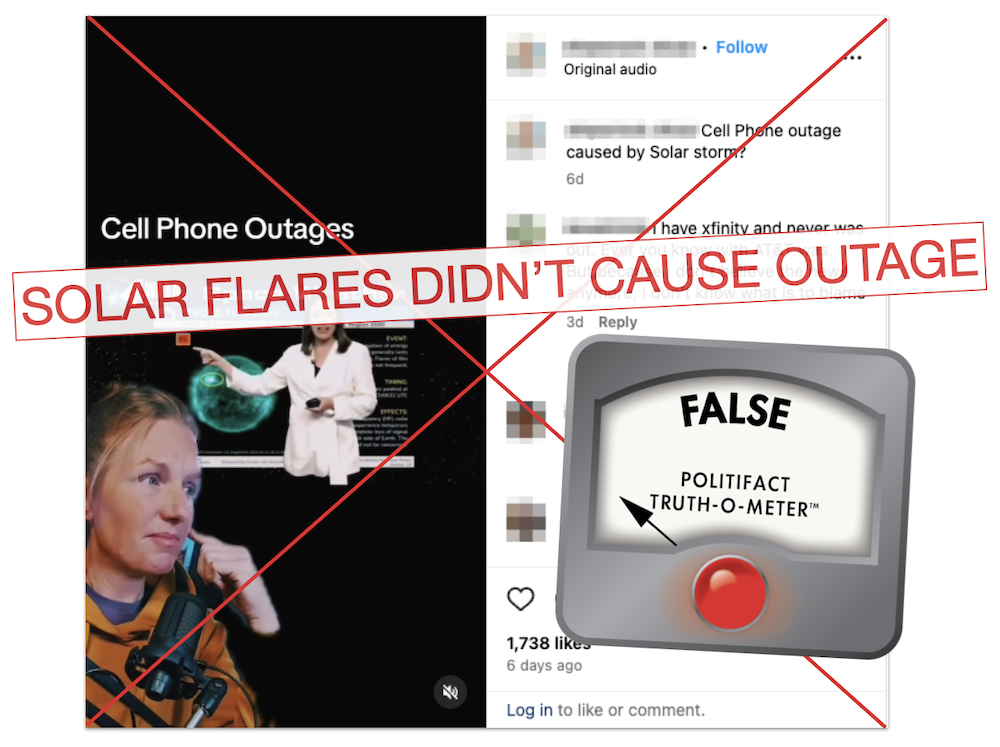Stand up for the facts!
Our only agenda is to publish the truth so you can be an informed participant in democracy.
We need your help.
I would like to contribute
Bad connection: Solar flares didn’t cause AT&T’s cellphone outage
If Your Time is short
-
Two solar flares occurred hours before a temporary outage disrupted AT&T cellphone customers’ service Feb. 22. But AT&T and experts said the two events are not connected.
-
Intense solar flares can disrupt radio communications, but the National Oceanic and Atmospheric Administration said it was "highly unlikely" the flares affected cellphone service.
-
AT&T said the outage was caused by technical issues.
- Learn more about PolitiFact’s fact-checking process and rating system.
After thousands of AT&T customers temporarily lost cellphone service Feb. 22, some social media users began speculating about what caused the outage.
A Feb. 22 Instagram reel’s narrator said, "A lot of people are blaming a solar flare that occurred last night and early this morning for this disruption because moments after it occurred is when the initial reports of outages started coming in."
The Instagram post’s caption read, "This Major Solar Flare and Cellular Service outage could just be a coincidence, but it is odd and interesting to think about."
Another Instagram post, also shared Feb. 22, also questioned whether a solar flare caused the outage.
(Screengrab from Instagram)
These posts were flagged as part of Meta’s efforts to combat false news and misinformation on its News Feed. (Read more about our partnership with Meta, which owns Facebook and Instagram.)
But solar flares weren’t to blame for this outage. Solar flares happen when magnetic fields on the sun reach a point of instability, releasing powerful bursts of electromagnetic radiation that can last minutes to hours, NASA said. NASA uses a scale, with B being the lowest and X being the strongest, to classify how strong solar flares are. Within each letter class, there’s another scale from 1 to 9, although X flares can go higher than 9.
Both of the recent solar flares were in the X-1 class, NASA said — so, relatively strong.
Depending on their intensity, solar flares can disrupt communication, radar and navigation systems on Earth, but it is "highly unlikely" these recent flares contributed to the widespread cellphone outages, the National Oceanic and Atmospheric Administration said.
Solar flares affect only the side of the Earth the sun is facing. Because it was nighttime in the United States when the flares occurred, they couldn’t have affected radio communication there, Ryan French, a solar physicist at the National Solar Observatory, said in a YouTube video about the event.
The sun emitted two strong solar flares, with one peaking at 6:07 p.m. EST on Feb. 21 and one at 1:32 a.m. EST on Feb. 22, NASA and NOAA said.
AT&T customers in the U.S. began reporting service problems at about 3:30 a.m. EST on Feb. 22, according to Downdetector, which tracks cellular and internet outages. On that day, the site said the reported outages for AT&T peaked at almost 74,000. AT&T said wireless service was restored to all affected customers by 3:10 p.m. EST.
When we asked AT&T about what triggered the outage, a spokesperson referred us to a company webpage. It said technical issues that occurred during work to expand AT&T’s network caused the temporary service disruption.
AT&T also ruled out that a "cyberattack," or a computer network hack, caused the outage, although that claim also circulated social media. The company said there was no evidence a third party was involved in the outage or that customer data was compromised. AT&T is offering a $5 credit to affected customers.
During the outage, AT&T said customers could still make calls and send text messages using Wi-Fi. In place of cell service, some iPhone users saw an "SOS" symbol on their screens; Apple said in these instances, users can still make emergency calls.
Some people who use other cellphone carriers, such as Verizon and T-Mobile, also reported service snags Feb. 22. Verizon and T-Mobile both said their networks were operating normally that day and problems were likely caused when trying to reach people on different networks.
We rate the claim that solar flares caused AT&T’s cellphone outage False.
Our Sources
Instagram post (archived), Feb. 22, 2024
Instagram post, Feb. 22, 2024
NASA, "What is a solar flare?," March 6, 2015
NASA, "X-Class: A Guide to Solar Flares," May 3, 2023
NASA, "Sun Releases Two Strong Flares – Solar Cycle 25," Feb. 22, 2024
National Oceanic and Atmospheric Administration, "Solar Flares (Radio Blackouts)," accessed Feb. 28, 2024
National Oceanic and Atmospheric Administration, "Two Major Solar Flares; Effects on Cellular Networks Unlikely," Feb. 26, 2024
YouTube, "Did a Solar Flare just Knock-out our Mobile Phone Network? (No)," Feb. 22, 2024
Downdetector, AT&T reported outages (archived webpage), Feb. 22, 2024
AT&T, "Network update," Feb. 25, 2024
AT&T, "Making it right," accessed Feb. 28, 2024
Instagram post, Feb. 22, 2024
Instagram post, Feb. 22, 2024
The New York Times, "AT&T Says Service Is Restored After Widespread Cellular Outage," Feb. 22, 2024
Apple Support, "If you see No Service, Searching, or SOS on your iPhone or iPad," Jan. 17, 2023
Verizon, "Verizon’s network remains fully operational," Feb. 22, 2024
T-Mobile, "T-Mobile network continuing to operate normally," Feb. 22, 2024
USA Today, "No, AT&T cellphone outage not caused by solar flares | Fact check," Feb. 26, 2024
Browse the Truth-O-Meter
More by Sara Swann
Bad connection: Solar flares didn’t cause AT&T’s cellphone outage
Support independent fact-checking.
Become a member!
In a world of wild talk and fake news, help us stand up for the facts.

































